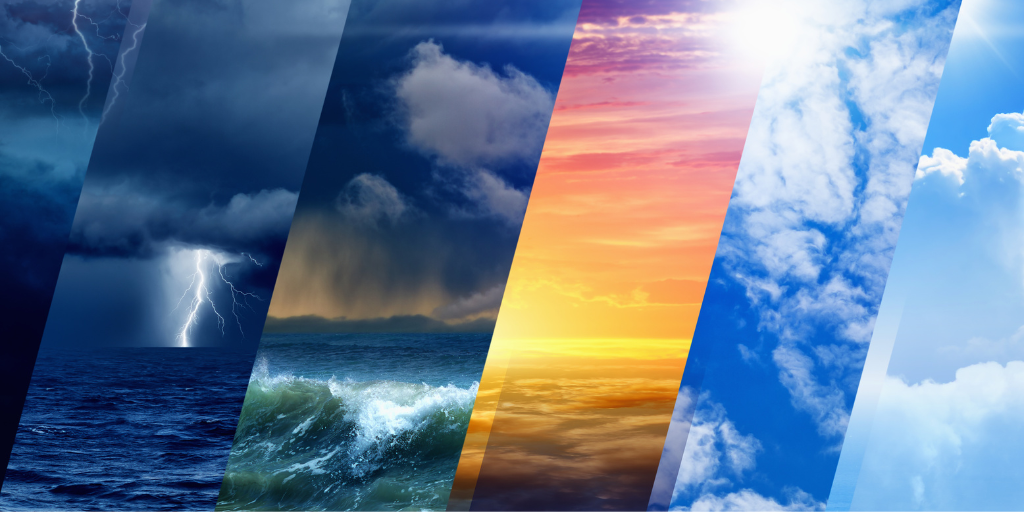Severe weather can strike your house of worship at any time.
Depending on where you are, it can come in the form of wildfires, hurricanes, flooding, tornadoes and wind gusts, just to name a few. Keep reading for intel on this summer’s predicted weather events and how to help mitigate them.
According to The Associated Press, extreme weather events like heavy precipitation, droughts and forest fires are not only becoming more common, they’re becoming more severe.
In the first half of 2023 alone, natural catastrophes caused $52 billion in insured loses—and houses of worship are not immune to this risk. For example, earlier this summer, severe thunderstorms and hale ripped off portions of the roof of a Baptist church in Great Bend, Kansas.
Based on the latest predictions, below are weather events your church may experience this summer and how to help prepare for them.
Forest Fires
Forest fires can happen anywhere in the country—especially when you consider that the Earth’s temperature has risen 0.08 degrees per decade—but here are a few areas that forecasters have noted could be particularly susceptible to forest fires this year:
- If you’re on the West Coast, you may have noticed conditions have become drier and warmer. This has led to longer fire seasons that burn more area than in recent years. In fact, the number of large fires occurring has doubled between 1984 and 2015 in the western United States. In the west, projections show that an average temperature rise of 1-degree C would increase the typical burned area per year by about 600% in some forest types. As outlined above, the temperature has been rising twice as fast since 1981. That means the temperature will rise by 1-degree C in just 55 years, making way for the 600% projected increase in burned areas.
- For Southeastern Pennsylvanians and New Jersians, this summer, the National Weather Service declared a “critical” fire danger due to dry conditions. Multiple blazes already occurred in New Jersey this spring.
- In the Pacific Northwest, there have been “Red Flag Warnings” issued, such as in Seattle, due to overly-dry vegetation. Those in parts of Washington and Oregon saw their “hottest and driest May on record.” Snowfall has also dramatically declined, paving way for heightened wildfire potential in the region through September.
- Other areas that are seeing unusually dry conditions are Michigan, which also issued a Red Flag Warning, as well as other Midwest states like Ohio and Wisconsin.
To prepare your house of worship for potential wildfires, check out Glatfelter’s Wildfire Mitigation and Structure Hardening overview.
Also, visit Glatfelter’s Severe Weather Resources page below and expand the “wildfires” section to view more content to help you be ready.
Hurricanes
Sea levels are rising–mostly due to melting ice sheets and glaciers and the expansion of seawater as it warms. Sea levels have risen by six inches since 1900, and nearly four of those risen inches have happened since 1970. Higher sea levels mean more land erosion and increased chance of flooding and storms. Warmer oceans mean more fueled storms. The combination has been devastating. If you’re near a coast, scientists say the most damaging hurricanes now happen three times more often than a century ago, and hurricanes in the Atlantic Ocean have doubled since 1980. At the same time, hurricanes are moving more slowly, causing increased damage.
This summer, the National Oceanic and Atmospheric Administration (NOAA) predicts 12-17 storms in the Atlantic, with 1-4 being major hurricanes.
To prepare for hurricane season, Glatfelter’s Severe Weather Resources page below on hurricanes, including property mitigation and hurricane preparedness tips.
El Nino
This summer, on top of already-increasing temperatures, we’re facing El Nino. El Nino is a warming of the ocean surface waters in the eastern tropical Pacific Ocean. El Nino comes from further increased temperatures and “supercharged” extreme weather. Depending on your region, you can expect more heatwaves, droughts, wildfires and floods. The states closest to the Pacific Ocean will see the biggest impacts. In some areas, like the northern U.S. and Canada, expect dryer and warmer conditions than normal. The last El Nino, which happened from 2014 to 2016, drove record-high global temperatures and left us with the hottest year on record – 2016.
To help your church prepare for El Nino, check out this California police department’s preparedness checklist.
Flooding
Floods are the most common (and among the most deadly) severe weather event. Scientists know that severe weather conditions have contributed to floods, such as increased heavy rainfall and excessive snowmelt. More flooding is occurring in the Mississippi River Valley, the Midwest and Northeast, and coastal flooding has doubled within decades.
Many churches have seen firsthand just how devastating these events can be, like the Mayfield, Kentucky church suffered from severe flooding and was deemed a “total loss” less than two years after they experienced a tornado.
This summer, roughly 146 million Americans are at risk of flooding. The National Weather Service has forecasted flooding in the following areas:
- Major flooding along portions of the Upper Mississippi River
- Moderate flooding along the Red River in North Dakota
- Moderate flooding along the James River in South Dakota
- Widespread flooding throughout California
- Minor to moderate flooding in the Sierra Nevada, Great Basin, and parts of the Central Rockies higher elevation basins
- Minor to moderate flooding in portions of the Upper Snake River
To help prepare for potential flooring, view Glatfelter’s Water Damage Prevention and Mitigation planning guide.
Also visit Glatfelter’s Severe Weather Resources page to follow our property mitigation tips and read a blog on flooding.
Here are some additional resources to help prepare your flock for severe weather impacts:
- How to prepare for a power outage from the Red Cross
- A guide to creating an Emergency Action Plan (EAP)
- A severe weather prep guide by a church security company
- The basic elements of an in-house safety/security committee
- An overview of preparing for mass-casualty events
- Roof Inspection Guidelines to help make sure your roof is ready for severe weather events
The takeaway for your congregation is to be ready for anything in this increasingly unstable climate. The consensus is: expect the unexpected. And, although this severe weather event list is not exhaustive, we hope that it can serve as a starting point to help you protect your property and, most importantly, people. For more information, check out the NOAA’s Storm Prediction Center, which provides further predictions on other severe weather events, such as tornadoes, wind damage and large hail.
DISCLAIMER
The information contained in this blog post is intended for educational purposes only and is not intended to replace expert advice in connection with the topics presented. Glatfelter specifically disclaims any liability for any act or omission by any person or entity in connection with the preparation, use or implementation of plans, principles, concepts or information contained in this publication.
Glatfelter does not make any representation or warranty, expressed or implied, with respect to the results obtained by the use, adherence or implementation of the material contained in this publication. The implementation of the plans, principles, concepts or materials contained in this publication is not a guarantee that you will achieve a certain desired result. It is strongly recommended that you consult with a professional advisor, architect or other expert prior to the implementation of plans, principles, concepts or materials contained in this publication.
This blog post may contain the content of third parties and links to third party websites. Third party content and websites are owned and operated by an independent party over which Glatfelter has no control. Glatfelter makes no representation, warranty, or guarantee as to the accuracy, completeness, timeliness or reliability of any third party content. References to third party services, processes, products, or other information does not constitute or imply any endorsement, sponsorship or recommendation by Glatfelter, unless expressly stated otherwise.
Related posts
In summer 2024, weather will be unpredictable, but these are the weather events you can expect, depending on location.
About the top 4 insurance claims houses of worship experience.
Cyberattacks on healthcare organizations have risen--so has the average cost. Read about how to help avoid being another statistic.


-1.png)





.png)

Submit a Comment